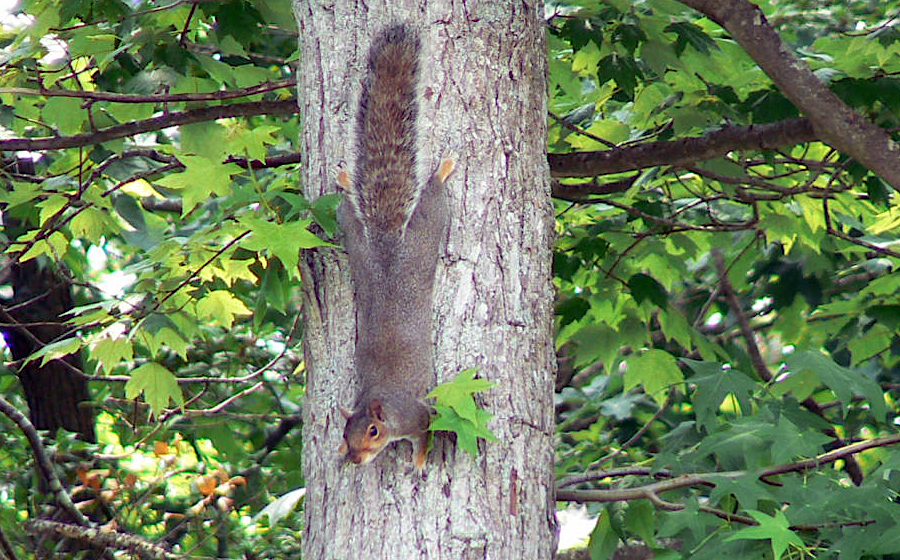
red squirrels (Tamiasciurus hudsonicus) prefer coniferous forests
Source: US Fish and Wildlife Service, American red squirrel
The Virginia Department of Wildlife Resources recognizes five species of squirrels within the state. There are two subspecies of northern flying squirrel (Glaucomys sabrinus), two subspecies of southern flying squirrel (Glaucomys volans), four subspecies of fox squirrel (Sciurus niger), two subspecies of gray squirrel (Sciurus carolinensis), and two subspecies of red squirrel (Tamiasciurus hudsonicus).1

red squirrels (Tamiasciurus hudsonicus) prefer coniferous forests
Source: US Fish and Wildlife Service, American red squirrel
Squirrels are famous for burying acorns and other nuts in the fall, then retrieving them throughout the winter as a food source. After initially grabbing 3,000-10,000 nuts each year, a squirrel has to decide whether to eat or cache it. An acorn from a white oak tree is more likely to sprout quickly and become unsuitable food if buried compared to a tannin-rich acorn from a red oak, so squirrels prefer to eat the white oak acorns and bury the red oak acorns.
Squirrels have excellent memories, an essential element in retrieving food buried months earlier in hundreds of different locations. They also have the ability to deceive. When a squirrel senses a competitor is observing its caching efforts and potentially steal its buried food, it can "fake" the deposit of a nut into the cache and then take the food to another location.2

the gray squirrel (Sciurus carolinensis) is easily spotted in city parks across Virginia
Source: US Fish and Wildlife Service, Eastern Gray Squirrel
Squirrels rely upon trees for food and shelter, and different species prefer different habitats. Red squirrels are more common in pine forests. Their territorial nature is revealed by their constant badgering if disturbed by the presence of a hiker on the forest floor below. One species n Virginia is labelled the talkative red squirrel (Tamiasciurus hudsonicus loquax).3
Gray squirrels are commonly seen in hardwood trees, including those planted along streets and within urban/suburban parks. Gray squirrels will nest in the early spring and again in the late summer, producing litters of three or four pups that reach maturity within nine weeks. Hawks and many other predators, including domestic dogs, typically keep the population in check.4
In 1878, two California gray squirrels were brought to Capitol Square in Richmond to restart a population there. The translocation was successful, and modern visitors to Capitol Square often feed the squirrels for entertainment:5

feeding the squirrels in Capitol Square has been a tradition in Richmond since the 1880's
Source: Frank Leslie's Illustrated Newspaper, Virginia - the South in 1880 - A Glimpse of Richmond (May 29, 1880)
Because the Division of Buildings and Grounds keeps the Capitol grounds neat by removing branches and fallen leaves, the squirrels do not have enough natural material to build nests on the 13.5 acre site. Since the 1940's the state has built wooden nest boxes for the squirrels, and also provides raw peanuts in the winter for food. The peanuts are not needed in the summer, because visitors share their lunches and snacks so generously.6
About 45,000 hunters in Virginia have a license to shoot squirrels. The bag limit is six per day. Gray and red squirrels may be harvested statewide in the Spring and Fall seasons. The Fall fox squirrel season is open in all counties west of the Blue Ridge plus Albemarle, Bedford, Culpeper, Fauquier, Franklin, Greene, Loudoun, Madison, Orange, Patrick, Prince William, and Rappahannock counties east of the mountains. In the Spring season, fox squirrels may not be hunted on National Forest land.7
The Delmarva Peninsula fox squirrel (Sciurus niger cinereus) and the [West] Virginia northern flying squirrel (Glaucomys sabrinus fuscus) have been removed from the list of threatened and endangered species. The Delmarva Peninsula fox squirrel was listed as endangered when he list was first established in 1967. The Virginia northern flying squirrel was added in 1985, at which time only 10 could be captured.
The Virginia northern flying squirrel is nocturnal, and feeds on lichens and fungi as well as seeds and nuts. It depends upon red spruce (Picea rubens) trees, which after the Ice Age were isolated on mountains. The Virginia northern flying squirrel is more commonly known as the West Virginia northern flying squirrel, and its primary range is in West Virginia. In Virginia, the squirrel has been documented from Highland and Montgomery counties.


identifying preferred habitat in the Monongahela National Forest (MNF) was an essential step in recovery of the Virginia northern flying squirrel subspecies
Source: US Fish and Wildlife Service, Environmental Conservation Online System, Five Yea Review: Summary and Evaluation (2006) and Virginia northern flying Squirrel (Glaucomys sabrinus fuscus)
Harvest of the red spruce trees, after railroads reached the mountains, dramatically reduced the available habitat. Regrowth in the warmer climate produced northern hardwood forests, and only 15% of the former area covered by red spruce forests remained by 1985.
Replanting red spruce trees helped restore the populations. Nest boxes have been installed in 10 Virginia counties as part of the species recovery effort.8

providing nest boxes also helped increase the number of Virginia northern flying squirrels
Source: US Fish and Wildlife Service, USFWS checks Northern Flying Squirrel nest box

one of the two subspecies of gray squirrel is present in every Virginia jurisdiction
Source: Virginia Department of Game and Inland Fisheries, gray squirrel (Sciurus carolinensis carolinensis) and northern gray squirrel (Sciurus carolinensis pennsylvanicus)

grey squirrels are acrobats as they navigate across tree branches
Source: US Fish and Wildlife Service, Eastern gray squirrel hanging from tree